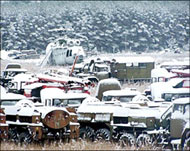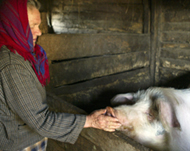Wildlife finds home in Chernobyl zone
The radioactive no-go zone around Chernobyl has become a rich natural reserve in the 20 years since the accident at the nuclear power plant, with eagles hovering in the air, and lynx, wolves and wild horses wandering around.

After the April 26, 1986, accident at the Soviet plant, 4,000sq km of land surrounding the Chernobyl plant was soaked with radiation. The area was evacuated and closed to humans.
In the two decades since, nature has had an almost free rein over this patch of land straddling the border between Ukraine and Belarus. The results have been impressive.
Take the Przhevalski horse, believed to be the only true modern descendant of the wild horse. In 1998, 17 of them were introduced to the area.
Today, officials who accompany visitors to the zone say the steeds number 80 to 90, and the area around Chernobyl is one of the few places in the world where they roam free.
Almost unperturbed by man, the flora and fauna have developed with virtually no human interference. About 350 “self-settlers” still live inside the zone, but this mainly elderly group generally keeps to its eight villages.
A visitor may see elk, fox, otter, beaver, wild boar, grey crane and the endangered great spotted eagle all in one day. Regular visitors say bears have been seen.
Perfect habitat
With so few people, the zone is the perfect habitat for endangered species. The Chernobyl International Radioecology Laboratory has recorded the presence of more than 400 animal species there, including 280 kinds of birds and 50 endangered species.
 |
|
Trucks, tanks and helicopters are |
Despite apocalyptic predictions at the time of the Chernobyl disaster, the animals living inside the forbidden zone are not abnormal, disproportioned mutants.
The ecosystem surrounding Chernobyl has passed through several stages since the accident, said Rudolph Alexakhin, director of the Agricultural Radiology Institute in Moscow.
During the first year-long phase, plants and animals most affected by the radiation died.
Some areas were so soaked with radioactivity that they had to be razed, such as a pine forest that became known as the Red Forest for the levels of radiation registered there.
Over the next six years, nature slowly recovered, Alexakhin said.
 |
|
Maria Semenyuk is among about |
Today it is coming back.
Serhiy Franchuk, a guide for the Chernobylinterinform – the state enterprise that provides the obligatory guides for all visitors – says that the pines planted in place of the Red Forest are thriving.
But even after two decades, signs remain that this is no ordinary wilderness zone.
The invisible, odourless and tasteless radiation permeates the buried buildings, cars and cattle, the earth that covers them and the rivers that flow nearby.
It will do so for a long time to come.